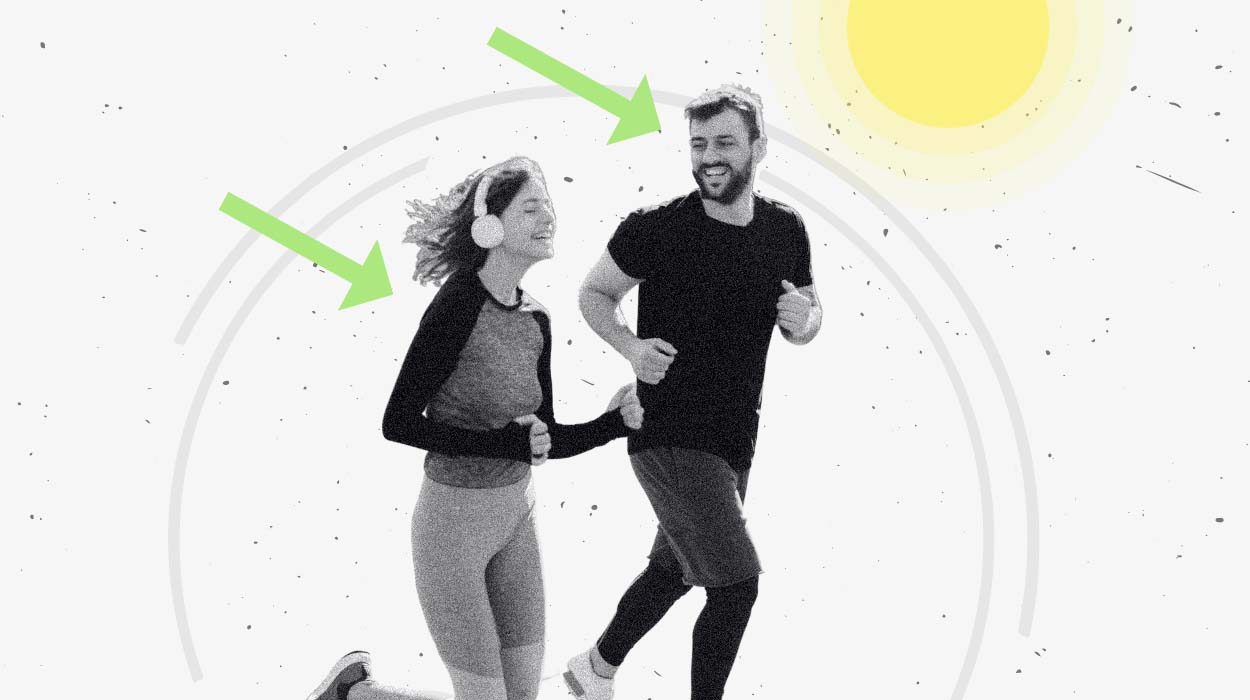
Your alarm rings next to your ear as you sleepily hit the snooze button to get another 15 minutes of sleep. You had big plans for a nice early morning workout but unfortunately, the desire for sleep overtook your motivation. We’ve all been in a similar situation, but, hopefully, after reading this article, you will be educated on the extreme benefits of a morning workout routine. According to American Heart Association (AHA), the best time for people to exercise is in the morning to improve and maintain cardiovascular health.[1]
We will review the benefits of morning exercise which range from weight loss to lowering blood pressure. We will also provide a comprehensive morning routine and exercise program to kickstart your day and it may even turn you into a morning person!
Good Morning Workout Routine: Six Best Exercises To Try
For this workout plan, you don’t need to even leave your house!
Six Morning Workouts To Energize Your Day
For the following exercises use your body weight and a jump rope. It is recommended to have a workout mat and make sure to hydrate! Some people prefer to work out on an empty stomach or have a light breakfast, but it is recommended you consult with a specialist to determine the safest way to approach morning exercise.
The most beneficial way to tackle this great workout is through high-intensity interval training, known as HIIT. Basically, you would do each of these exercises at maximum effort and then rest for about 1-2 minutes, and then move to the next exercise.
High Knees
This exercise engages the lower body muscles, enhancing leg strength and coordination. High Knees also promote core activation, helping improve posture. They elevate your heart rate and metabolism, jumpstarting your day with increased energy and alertness.
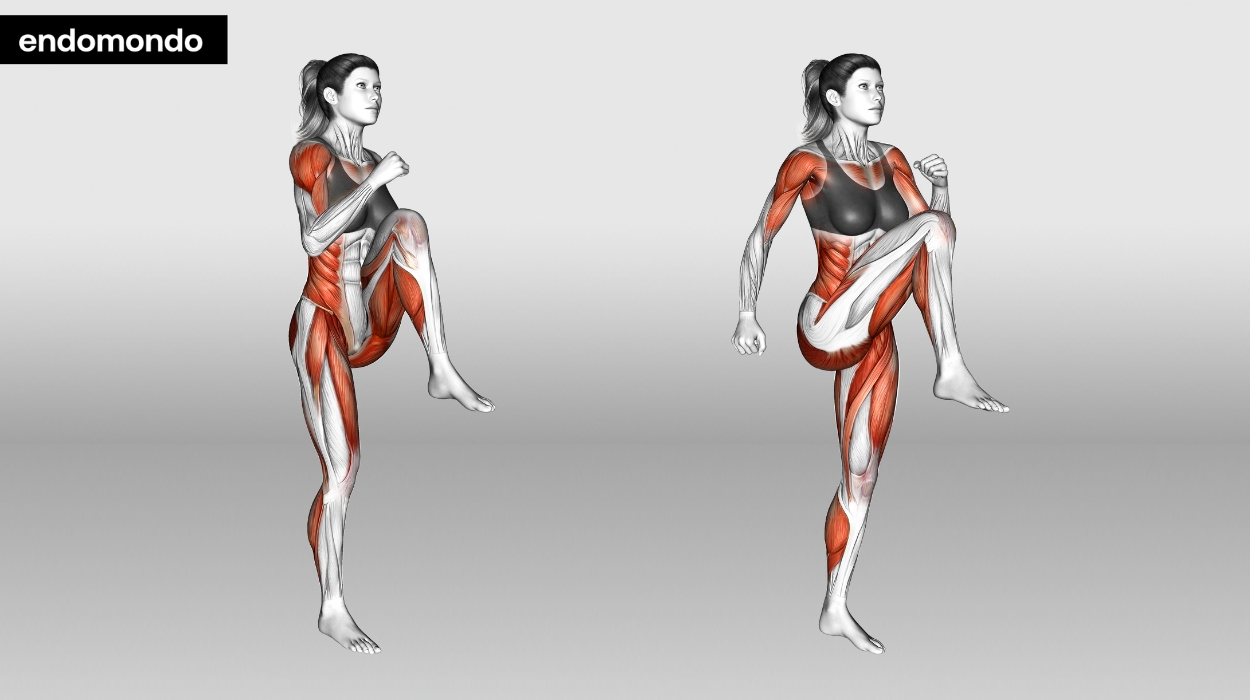
How to do:
- Stand at a starting position with your feet hip-width apart.
- Start by jogging in place, lifting your knees as high as possible while pumping your arms.
Tips:
- Lift Those Knees: Focus on bringing your knees as high as possible with each step while maintaining a brisk pace to engage your core and boost intensity.
- Stay Light on Your Feet: Land softly on the balls of your feet to minimize impact and reduce stress on your joints during High Knees.
- Controlled Breathing: Breathe rhythmically to sustain your effort.
Optimal Sets and Reps: three sets of 30 seconds
Mountain Climbers With Push-Up
This dynamic combo engages the entire body, enhancing cardiovascular fitness, strengthening the upper body, and building core stability. It jumpstarts metabolism, increases energy levels, and improves mental alertness to kickstart your day.
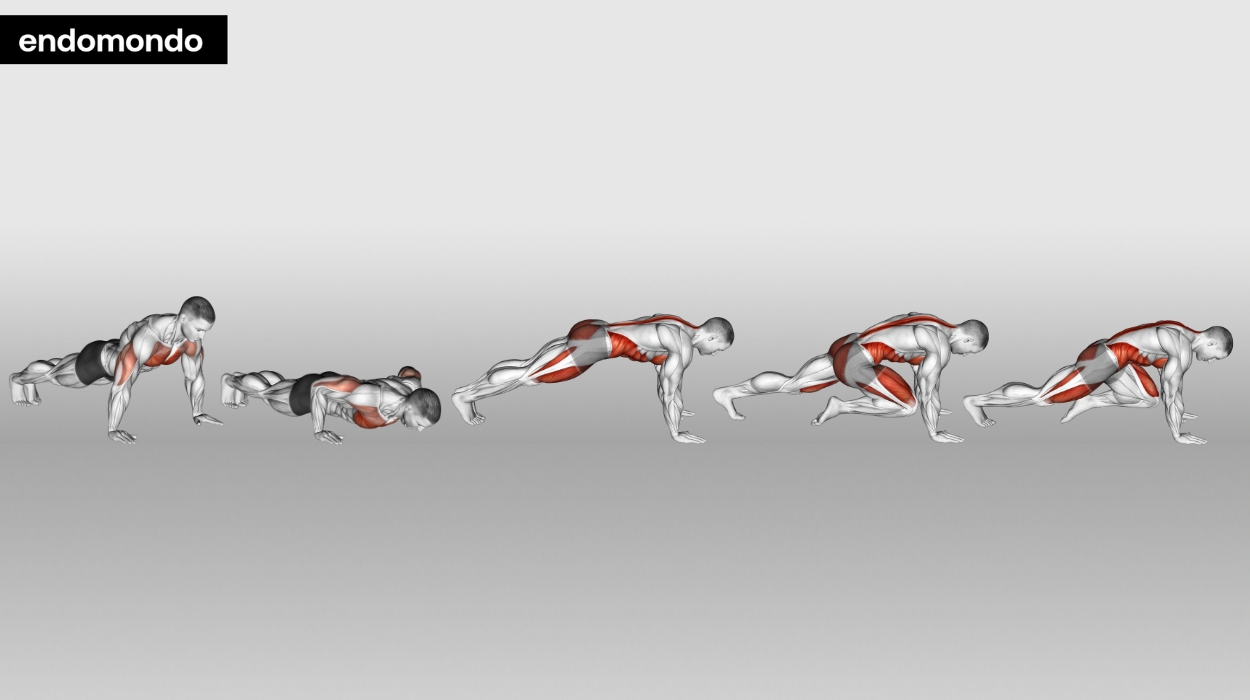
How to do:
- Start in a high plank position.
- Lower your body into a push-up, then push back up, keeping your elbows bent at a slight angle.
- Engage your core the entire time and alternate driving your left knee to your left elbow and your right knee towards your right elbow, as if climbing a mountain.
Tips:
- Maintain Proper Alignment: Keep your body in a straight line from head to heels during Mountain Climbers with Push-Up, engaging your core to prevent sagging or arching.
- Control Your Pace: Perform each movement with control, bringing your knees to your chest and executing the push-up with proper form. This ensures a challenging yet safe workout.
- Breathe and Energize: Focus on steady breathing throughout the exercise to maintain energy levels and optimize the effectiveness of your morning workout.
Optimal Sets and Reps: three sets of 10 to 15 reps
Burpees
Burpees engage multiple muscle groups, enhancing strength and endurance. They boost metabolism, burn calories, and increase heart rate, helping you wake up and feel more alert. The exercise also releases endorphins, promoting a positive mood and reducing morning grogginess.
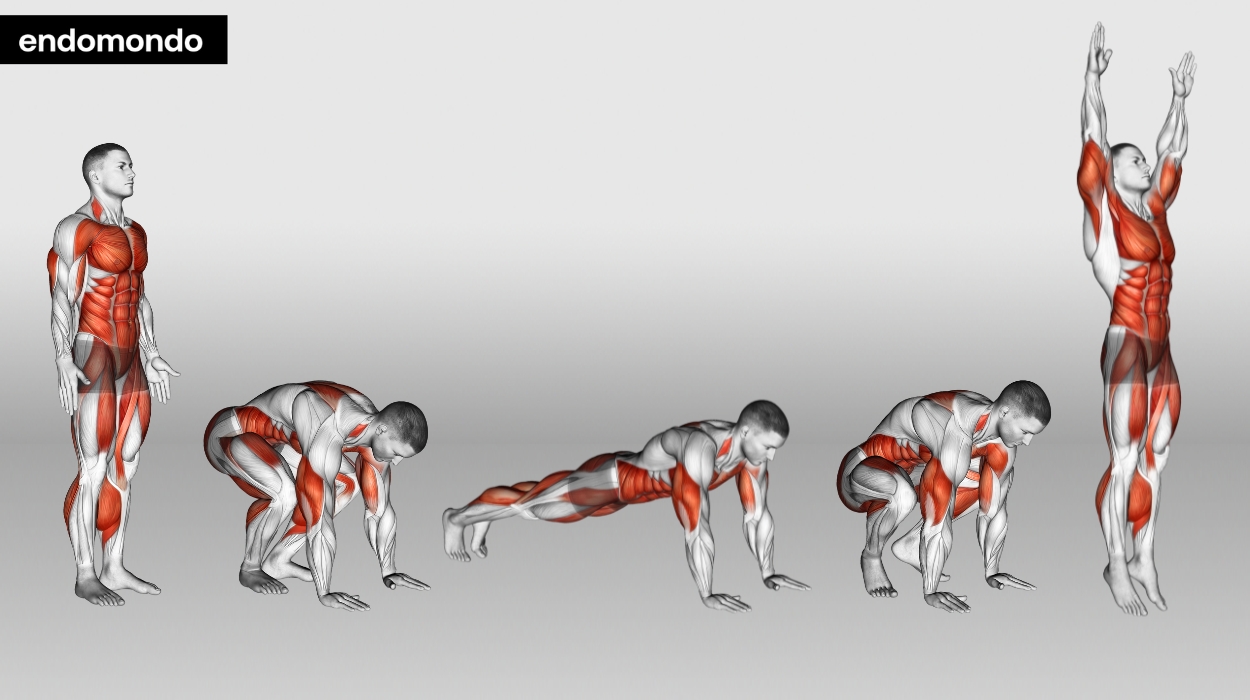
How to do:
- Begin in a standing position with your feet shoulder-width apart.
- Go into a squat position and then place your hands on the ground in front of you.
- Kick your feet back and get into a high-plank position then do a pushup and push back up while explosively jumping into the air.
Tips:
- Full-Body Engagement: Ensure a smooth flow by engaging your core, performing the squat, push-up, and jump explosively. This maximizes the benefits of the Burpee.
- Maintain Proper Form: Maintain a neutral spine throughout, and land softly when jumping to protect your joints. Proper form is essential for safety and effectiveness.
- Controlled Breathing: Focus on controlled breathing to sustain your energy throughout the exercise. Inhale during the squat and push-up, and exhale when jumping to maintain a steady rhythm.
Optimal Sets and Reps: three sets of 12 to 15 reps
Jumping Jacks
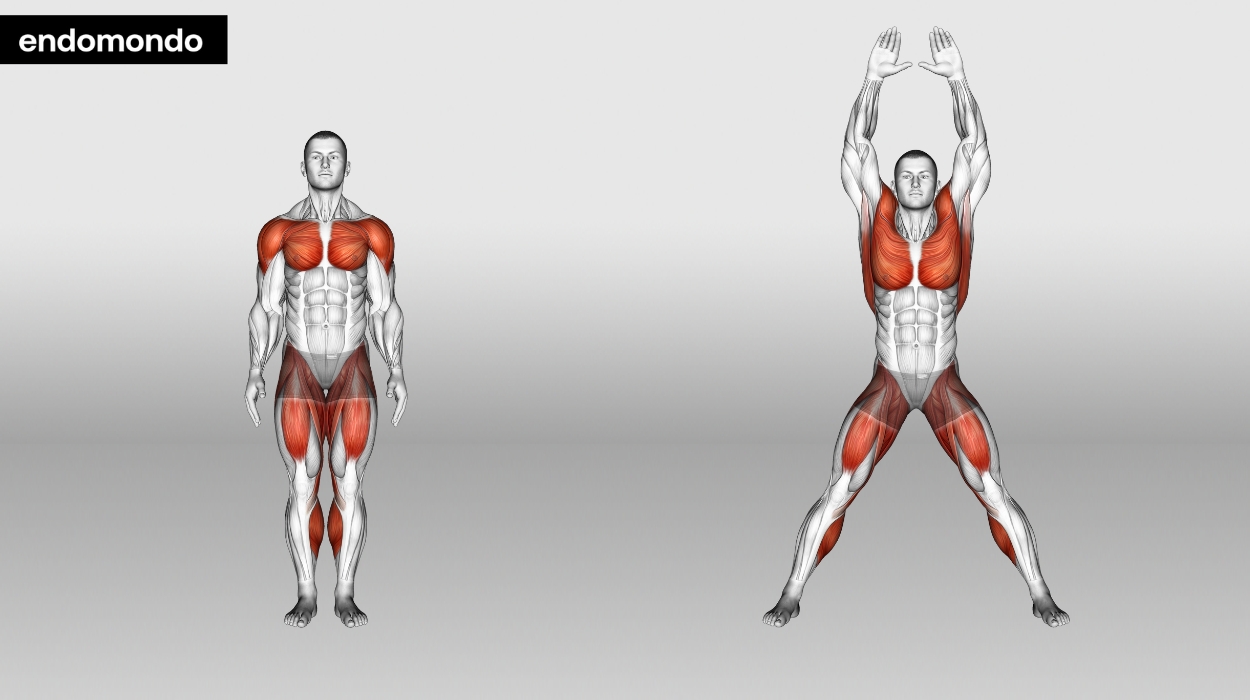
This dynamic movement engages your entire body, improving flexibility and coordination. Incorporating Jumping Jacks into your morning routine is a great way to kickstart your metabolism, improve your energy levels, and promote a healthy start to your day.
How to do:
- Begin by standing with your feet together and your arms by your sides.
- Jump up quickly, spreading your legs wider than hip-width apart.
- As you jump, simultaneously raise your arms out to the sides to form a “Y” shape with your body.
- Reverse the motion by bringing your legs together and your arms down.
Tips:
- Start Slow and Gradually Increase Speed: Begin Jumping Jacks at a moderate pace, ensuring proper form, and then gradually pick up the speed. This minimizes the risk of injury and helps maintain good technique.
- Engage Your Core: Keep your abdominal muscles tight throughout the exercise to stabilize your body and maximize the benefits for your core muscles.
- Land Softly: Land with a slight bend in your knees to reduce impact on your joints. This ensures a safer and more comfortable workout, especially during a morning routine when your body may be less warmed up.
Optimal Sets and Reps: three sets of 30 to 60 seconds
Jumping Lunges
They kickstart your day with an explosive lower body exercise, increasing heart rate and blood flow, providing an energy boost, and improving cardiovascular fitness. This dynamic movement engages multiple muscle groups, enhancing leg strength, balance, and coordination. Additionally, it fires up your metabolism, helping with calorie burn and weight management.
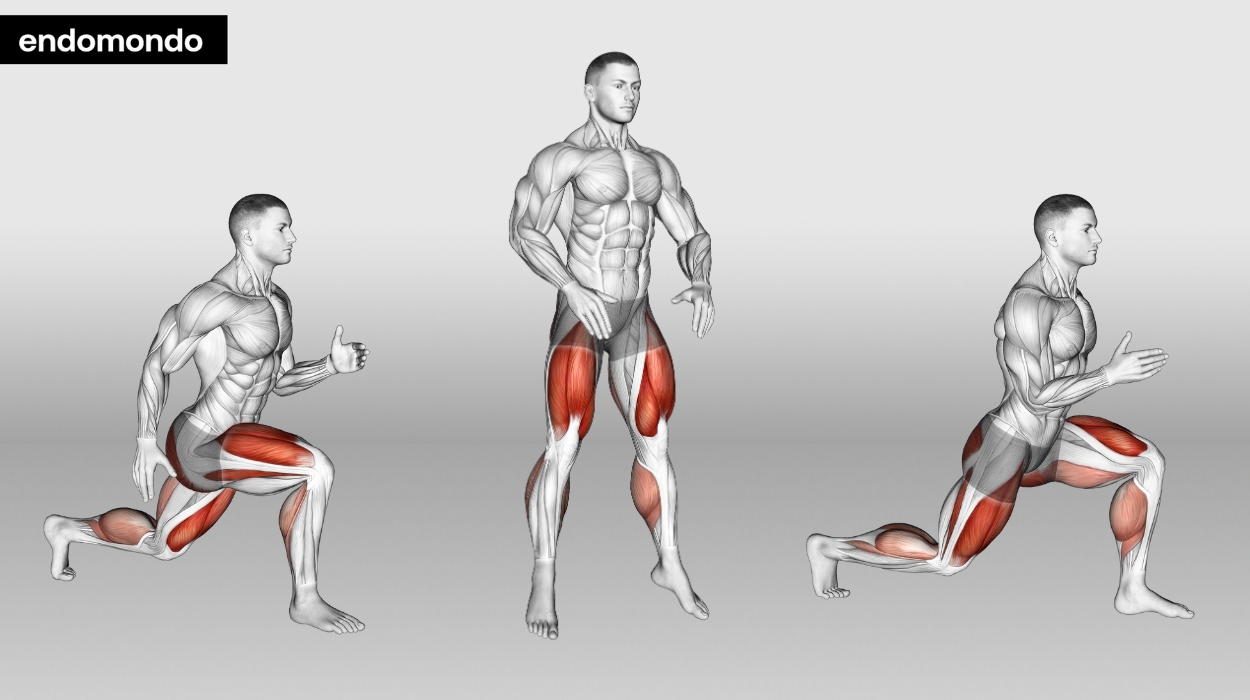
How to do:
- Start in a lunge position with your right leg forward and your knee bent at a 90-degree angle.
- Keep your left leg extended behind you.
- Lower your body into a lunge by bending both knees, making sure your front knee does not extend beyond your toes.
- Quickly jump up, switching your leg positions mid-air.
Tips:
- Maintain Proper Form: Start in a lunge position with both knees at 90-degree angles and jump explosively, switching legs mid-air. Ensure your knees align with your ankles to prevent injury.
- Land Softly: Upon landing, bend your knees to absorb the impact, reducing stress on your joints. Focus on a controlled, balanced movement throughout.
- Engage Your Core: Keep your core tight to stabilize your body during Jumping Lunges. This helps improve balance and strengthens your abdominal muscles.
Optimal Sets and Reps: three sets of 12 to 15 reps
Jump Rope
Jumping rope not only boosts metabolism, burns calories, and improves cardiovascular health but it also enhances coordination, agility, and balance, which can help kickstart your day with increased energy and mental alertness. It’s a low-impact exercise suitable for all fitness levels and can be done anywhere, making it a convenient option for morning routines.
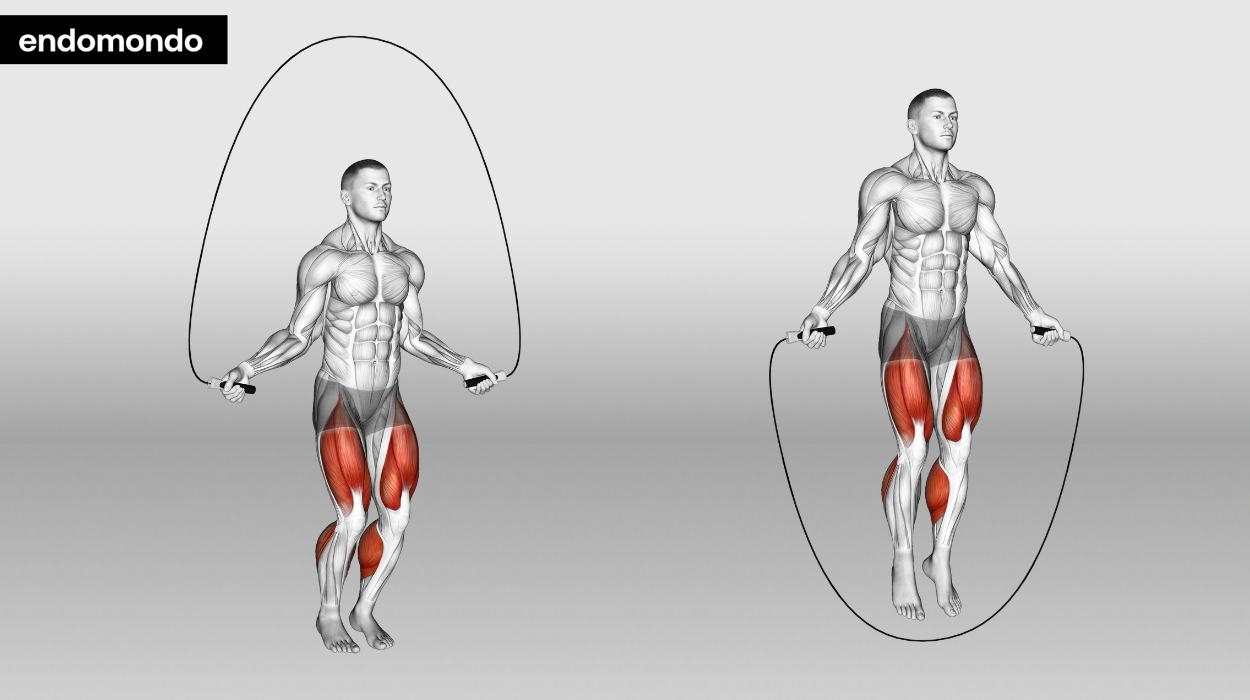
How to do:
- You can either use an actual jump rope or pretend to be holding a jump rope for this one.
- Start by holding the handles and positioning the rope behind you.
- Swing the rope over your head, using your wrists and forearms, and jump with both feet to clear it.
Tips:
- Proper Rope Length: Adjust your jump rope to the right length; it should reach your armpits when you stand in the middle of it to ensure efficient and injury-free jumping.
- Light and Controlled Landings: Land softly on the balls of your feet to reduce impact on your joints. Maintain a relaxed grip on the handles and use your wrists for rotation.
- Consistent Breathing: Sync your breathing with your jumps, inhaling as you rise and exhaling as you land. This rhythmic pattern helps maintain stamina and focus during your morning workout.
Optimal Sets and Reps: three sets of two to five mins
Is It Good To Work Out In The Morning?

It’s no secret that exercise and eating well are key components to both weight loss and overall health. Additionally, evidence suggests that morning exercise may be the BEST time to achieve results. One study[2] found that adults who exercised in the morning lost an average of 5 pounds of body weight compared to an average of 3 pounds for those who exercised in the evening.
Additionally, morning exercise may fit better into your lifestyle. If you are struggling to stick to an exercise routine on an already busy day, then exercising before the day begins may be easier to maintain. Exercising at a consistent time every morning reduces the need for planning and makes the day more complex. Additionally, having a set time for every day is a dependable way to create habits.
Three Benefits Of A Morning Workout Routine
The American Heart Association[1] encourages people who are overweight or have heart disease to exercise in the morning after a light breakfast. The most beneficial type of exercise is called aerobic exercise. Aerobic exercise means getting your heart rate up and your blood pumping. Many types of activities can be considered aerobic exercises that will be further discussed. The best exercises for weight loss are mostly aerobic. Activities such as running, swimming, biking, dancing, strength training, brisk walking, and sports all fall within the category of aerobic exercise. In a study by The American Medical Association, it was found that people who exercised for at least 30 minutes a day, 5 days a week, were more likely to lose weight and keep it off than those who did not exercise.
Boosts Metabolism
Metabolism is higher in the morning[2] which leads to increased energy levels and calorie burning throughout the day. Morning exercise helps to improve blood flow throughout the body, including to the muscles. This can improve the body’s ability to use glucose for energy, which in turn increases metabolism. General exercise increases muscle mass which burns more calories while at rest as compared to fat.
Improves Insulin Sensitivity
Various studies demonstrate that morning exercisers have lower levels of insulin resistance and inflammation[2] which play a role in metabolic diseases such as diabetes. In one study,[2] participants demonstrated improved insulin sensitivity after 6 weeks of exercising in the morning 3 times a week. Insulin sensitivity is a measure of how well cells respond to insulin. This is likely because morning exercise helps to increase the production of adiponectin, a hormone that helps to improve insulin sensitivity. Adiponectin is produced by fat cells, and levels of adiponectin are typically higher in the morning than in the evening.
Better Sleep
People who exercise in the morning, specifically obese individuals, report better sleep outcomes and improved quality of sleep.[3] Individuals in the morning group were assigned to work out 30 minutes for 3 days per week for 12 weeks at 8:00. By the end of the 12 weeks they demonstrated significant improvement in subjective sleep quality, decreased day-sleepiness, fatigue, and overall quality of life. This is likely since morning exercise can help to alter the circadian rhythm, which is the body’s natural sleep-wake cycle.
What To Consider Before Working Out In the Morning

Before exercising in the morning, there are several things you should consider for safety and to optimize your workout. Here are some key considerations:
- Sleep: Make sure you get enough quality sleep the night before your morning workout; 7-9 hours is considered the optimal range.
- Hydration: Hydrate yourself adequately before your workout. Drink a glass of water as soon as you wake up and stay hydrated throughout your day. 8 cups of water is recommended per day.
- Fuel your body: Have a light snack or breakfast before your workout, if you are not fasting. You can consider taking metabolism-boosting supplements. You can see LeanBean reviews here.
- Warm-up: It’s very important to warm up your body before any intense exercise via stretching or light cardio.
- Health considerations: If you have any underlying health conditions or concerns, it’s recommended to consult with a healthcare professional before starting a morning workout routine. They can provide educated guidance and ensure your exercise plan aligns with your specific needs. For older folks, there are some exercises to avoid over 60
Conclusion
To summarize, we’ve provided you with a range of benefits that result from morning exercise. We have provided you with a simple and effective workout routine that is sure to get your heart pumping during your morning workout. Morning exercise not only helps you shed those pounds but also provides you with a beneficial blueprint for the rest of your day. Give it a try and notice the changes in your energy levels, mood, sleep quality, and overall well-being.
Frequently Asked Questions
For beginners, low-impact aerobic exercises like walking, jogging, or cycling and simple HIIT exercises are great options. Additionally, bodyweight exercises such as squats, lunges, and push-ups can be incorporated into strength training without the need for equipment.
It depends on personal preferences and goals. Some people find that a light snack provides enough fuel to get through a workout while others may prefer exercise during the fasting period. It’s important to listen to your body’s needs and always consult a healthcare professional for the best advice.
Aim for at least 30 minutes of moderate-intensity exercise. If time is limited, a high-intensity interval training (HIIT) workout for 15-20 minutes can be effective in boosting cardiovascular fitness and burning calories.
Resources
- Øivind Rognmo, Trine Moholdt, Bakken, H., Hole, T., Per Mølstad, Nils Erling Myhr, Jostein Grimsmo and Ulrik Wisløff (2012). Cardiovascular Risk of High- Versus Moderate-Intensity Aerobic Exercise in Coronary Heart Disease Patients. Circulation, [online] 126(12), pp.1436–1440. doi:https://doi.org/10.1161/circulationaha.112.123117.
- Schumacher, L.M., J. Graham Thomas, Raynor, H.A., Rhodes, R.E. and Bond, D.S. (2020). Consistent Morning Exercise May Be Beneficial for Individuals With Obesity. Exercise and Sport Sciences Reviews, [online] 48(4), pp.201–208. doi:https://doi.org/10.1249/jes.0000000000000226.
- Saidi, O., Colin, E., Rance, M. and Pascale Duché (2021). Effect of morning versus evening exercise training on sleep, physical activity, fitness, fatigue and… [online] ResearchGate. Available at: https://www.researchgate.net/publication/352402041_Effect_of_morning_versus_evening_exercise_training_on_sleep_physical_activity_fitness_fatigue_and_quality_of_life_in_overweight_and_obese_adults.




